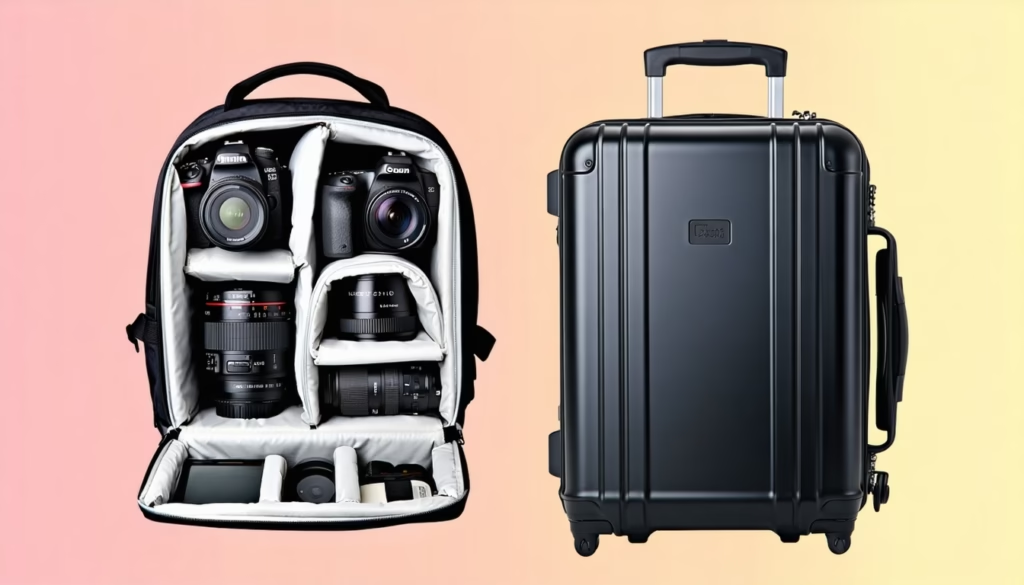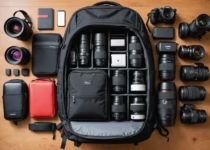Camera Backpack vs. Hard Case: The Ultimate Showdown!

Camera Backpack Versus Hard Case
If you’ve ever asked “camera backpack vs. hard case: which is better”, you’re not alone. Choosing the right way to carry your gear can make or break a shoot, whether you’re trekking through a rainforest or hopping on a plane. In this guide, you’ll get a clear breakdown of both options, so you can decide with confidence.
You’ll learn about features, protection levels, comfort, cost, and real-world use cases. By the end, you’ll know exactly which solution matches your shooting style and travel habits.
Understanding Camera Backpacks
Camera backpacks have climbed the ranks as a photographer’s go-to option. They blend protection, organization, and mobility in one package.
Features And Benefits
- Padded camera compartments keep bodies and lenses snug
- Modular dividers let you customize layouts on the fly
- Side or top access panels speed up lens swaps
- Integrated straps or loops for tripods and accessories
- Laptop sleeves for tethered editing sessions
You’ll find plenty of designs packed with tech, from weather-resistant fabrics to anti-theft zippers. If you need a deep dive on must-have features, check out essential features every photographer should want in a backpack.
Ideal Use Cases
- Urban photography, where quick access to gear lets you chase the perfect street shot
- Day trips and hikes, thanks to lightweight frames and ergonomic straps
- Studio or event work, when you need laptop space alongside cameras
- Multi-destinations travel, since backpacks fit most overhead bins
Need tips on organizing lenses inside your pack? Take a peek at our guide on the best ways to organize lenses inside a camera backpack. And if you plan to tote a tripod, here’s how to carry a tripod using a camera backpack.
Exploring Hard Cases
Hard cases, often made of high-impact plastic with customizable foam inserts, bring military-grade protection to your camera kit.
Features And Benefits
- A rigid shell absorbs heavy impacts and crushing forces
- Waterproof or dustproof seals guard against moisture and grit
- Stackable designs for studio storage or shipping
- TSA-approved locks keep expensive gear secure
- Removable foam allows for tailor-made compartments
These cases shine when you absolutely cannot risk damage. Picture your camera surviving a drop from a conveyor belt at the airport without a scratch.
Ideal Use Cases
- Air travel or checked baggage, where rough handling is common
- Expeditions in harsh climates, like desert or arctic shoots
- Shipping or storage of high-value gear between studios
- Underwater or marine photography, paired with sealed cases
Comparing Transport Performance
Wondering how a backpack stacks up against a hard case on the move? This table gives a quick snapshot.
| Feature | Camera Backpack | Hard Case |
|---|---|---|
| Average Weight | 2–5 lbs | 6–15 lbs |
| Carry Style | Backpack straps | Handle or wheels |
| Access Speed | Quick side or top panel | Slow foam removal is required |
| Expandability | Adjustable dividers | Fixed compartments |
| Travel Compatibility | Overhead bin friendly | Checked bag or cargo only |
Weight And Portability
Backpacks generally weigh less, so you can roam all day without fatigue. Hard cases add bulk, especially when loaded with dense foam inserts. If you’re hiking or biking, a pack makes more sense.
Access Speed
Need to swap lenses on the fly? Backpacks let you unclip a side pocket or lift a top flap in seconds. Hard cases demand removal of the lid and shifting foam layers, which can cost precious time.
Assessing Protection Level
Both options protect gear, but they do it differently. Let’s break down impact resistance and weatherproofing.
Impact Resistance
- Camera Backpack: Offers cushioned padding and shock-absorbent linings. Great for bumps and minor drops.
- Hard Case: Rigid shell disperses heavy shocks and stops crushing. Ideal for extreme force.
What’s more important, cushioning or unyielding defense? If you worry about sharp blows, a hard case wins. For general knocks, a backpack does the job.
Weatherproofing
Most camera packs use water-resistant fabrics, taped seams, and rain covers. If you want a walkthrough on choosing truly waterproof models, see what to look for in a waterproof camera backpack. Hard cases often boast IP67 or higher ratings, meaning you can submerge them briefly without moisture seeping in.
Evaluating Portability And Comfort
Comfort is key when you’re hauling gear all day. Let’s look at ergonomics and carrying options.
Ergonomics And Fit
- Backpack: Adjustable shoulder straps, padded hip belts, ventilated back panels. Distributes weight well.
- Hard Case: Handle only, sometimes wheels. No back support, which can strain wrists or shoulders.
Concerned about back pain? Learn how to prevent back pain when carrying camera gear.
Carrying Options
Backpacks free your hands and let you tackle stairs or rough terrain easily. Hard cases rely on wheels, which work great on smooth surfaces, but struggle on gravel or sand. Some photographers use both—a backpack for daily shoots and a hard case for long-haul trips.
Weighing Cost And Value
Budget matters, but so does long-term reliability. Here’s how prices typically compare.
Price Ranges
- Entry-Level Camera Backpack: $50–$150
- Mid-Range Camera Backpack: $150–$300
- Premium Backpack: $300–$600
- Basic Hard Case: $100–$200
- Professional Hard Case: $200–$500+
Long-Term Investment
Backpacks might need replacement after heavy use or if the padding compresses over the years. Hard cases cost more up front, but they often outlast multiple camera bodies. Factor in the repair or replacement of foam inserts when you budget.
Choosing The Right Option
At this point, you know the pros and cons of both setups. Let’s match your needs to the best choice.
Match To Shooting Style
- Adventure and landscape shoots: lean toward a rugged pack for mobility
- Studio or commercial jobs: consider a hard case for rock-solid gear protection
- Street and event photography: a backpack gives speed and stealth
Consider Travel Needs
- Frequent flyers: backpacks fit cabin limits, while hard cases go below deck
- Car-based road trips: you could bring both—a case for storage and a pack for day use
- Remote expeditions: a sturdy case paired with foam inserts keeps gear safe during shipping
Frequently Asked Questions
Should I Carry My Camera Gear In A Backpack Or Hard Case?
It depends on your shoot style. If you need quick lens swaps and hands-free movement, go backpack. For maximum impact and water resistance, choose a hard case.
Can I Check A Hard Case On A Plane?
Yes, hard cases are built to handle rough baggage handling. Just lock it and tag it as fragile for extra care.
Are There Backpacks With Hard Case Protection?
Some hybrid models feature a semi-rigid shell around critical zones. You can also slide a mini hard case inside your pack for extra security.
How Do I Clean And Maintain A Hard Case?
Wipe down the exterior with a damp cloth, check seals for debris, and let it dry fully before storage. Replace foam inserts if they start to break down.
Can I Fit Multiple Lenses Reliably In A Hard Case?
Absolutely. Customize the foam to match your lens shapes for snug, scratch-free storage.
Which Option Is Better For Outdoor Adventure?
A backpack usually wins for mobility on trails. If you need to ship your kit in, pack lenses in a hard case until you reach base camp.
How Do I Prevent Back Pain When Carrying Gear?
Adjust straps to balance weight on your hips, take frequent breaks, and pack only what you need. Check out our guide on how to prevent back pain when carrying camera gear.
Final Thoughts And Next Steps
Picking between a camera backpack and a hard case boils down to your shooting routine, travel style, and protection needs. Backpacks excel at agility and speed, while hard cases stand guard against extreme impacts and water exposure.
Take a moment to list your typical shoot scenarios—urban, wilderness, air travel—and match them to the strengths outlined here. Whichever you choose, you’ll be set to capture every moment without worrying about your gear.


